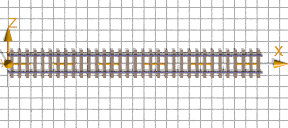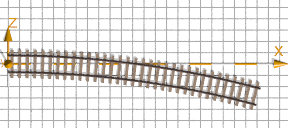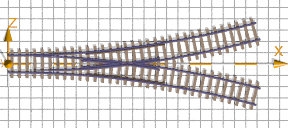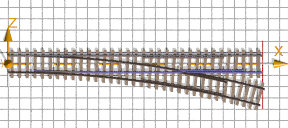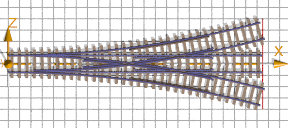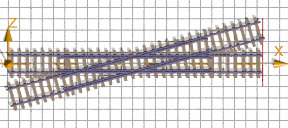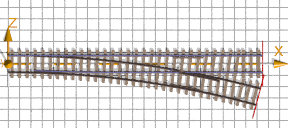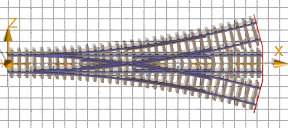Home
- Tutorial POV-Ray
- Ferromodellismo
Modellismo ferroviario
con POV-Ray
Index of Content
- Mio 'Rail Track System',
un sistema di binari
per POV-Ray
Elementi di base dei binari
- Binari diritti e curvi
- Scambi o deviatoi
- Scambi Y e a 3 vie
- Incroci
- Uso semplificato con
RT_System_00.inc
> Gli elementi binari
di RT_System_00.inc
- Binari adattati alle
scale di fermodellismo
- Binari in scala H0
- Binari in scala N
- Binari in scala Z
- Piani Binari con
binari adattati
- Posa dei binari
- Binari su e giù
- Piani Binari Esempi
- Semplice ciclico
- Otto semplice
- Download
Rail Track System
|
Per attivare gli oggetti seguenti,
dobbiamo agiungere:
Nota: Dobbiamo includere questo solamente una volta!
|
#include "RT_System/RT_System_00.inc" |
|
|
RT_Track_Straight_0
|
object{ RT_Track_Straight_0( 0, // Simulation_Type,
22.5,// Track_Length, meter
1.5, // Ties_Per_Meter
) //-------------------------
scale<1,1,1> rotate<0,0,0>
translate<0.00,0.00,0.00>
} //--------------------------------------------------// |
|
|
RT_Track_Curve_0
|
object{ RT_Track_Curve_0( 0, // Simulation_Type,
85.00 // Curve_Radius, meter
15, // Curve_Angle, degrees
1.5, // Ties_Per_Meter
) //-------------------------
scale<1,1,1> rotate<0,0,0>
translate<0.00,0.00,0.00>
} //--------------------------------------------------// |
Per una curve a sinista si usa ' scale<1,1,-1>' .
|
|
RT_Track_Switch_Y_0
|
object{RT_Track_Switch_Y_0(
0, // Simulation_Type,
0, // Direction: 0=right, 1=curve
85.00, // Switch_Radius, meter
15, // Switch_Angle, degrees
1.5, // Ties_Per_Meter
) //-------------------------
scale<1,1,1> rotate<0,0,0>
translate<0.00,0.00,0.00>
} //--------------------------------------------------// |
|
Deviatoi o Scambi e Incroci
di Tipo A:
|
Per le posizioni in un piano binari molto utile:
#declare Switch_Length = 22.50 ;
#declare Switch_Angle = 15 ;
#declare Switch_Radius =
Switch_Length/(sin(radians(Switch_Angle)));
#declare Rail_Distance =
2*Switch_Radius*(1-cos(radians(Switch_Angle))); |
|
|
RT_Track_Switch_A_0
|
object{ RT_Track_Switch_A_0(
0, // Simulation_Type,
0, // Direction: 0 = straight, 1 = right
22.50, // Switch_Length, meter
15, // Switch_Angle, degrees
1.5, // Ties_Per_Meter
) //-------------------------
scale<1,1,1> rotate<0,0,0>
translate<0.00,0.00,0.00>
} //--------------------------------------------------// |
Per un deviatoio a sinistra si usa ' scale<1,1,-1>' .
|
|
RT_Track_Switch_3Ways_A_0
|
object{ RT_Track_Switch_3Ways_A_0(
0, // Simulation_Type,
0, // Direction: 0=straight, 1=right, 2=left
22.50, // Switch_Length, meter
15, // Switch_Angle, degrees
1.5, // Ties_Per_Meter
) //-------------------------
scale<1,1,1> rotate<0,0,0>
translate<0.00,0.00,0.00>
} //--------------------------------------------------// |
|
RT_Track_Level_Junction_0
for switch type A
|
#declare Crossing_Angle = 15;
#declare Main_Length = 22.50 ;
#declare End_Distance =
Main_Length*tan(radians(Crossing_Angle));
#declare Cross_Length =
sqrt(pow(Main_Length,2)+pow(End_Distance,2));
//----------------------------------
object{ RT_Track_Level_Junction_0(
0, // Simulation_Type,
0, // Direction: 0 = straight, 1 = right
Crossing_Angle, // degrees
Main_Length, // meter
Cross_Length, // meter
1.5, // Ties_Per_Meter
) //-------------------------
scale<1,1,1> rotate<0,0,0>
translate<0.00,0.00,0.00>
} //--------------------------------------------------// |
Per un încrocio verso altro lato si usa '-Crossing_Angle' .
|
Deviatoi o Scambi e Incroci
di Tipo B:
|
Per le posizioni in un piano binari molto utile:
#declare Switch_Length = 22.50 ;
#declare Switch_Angle = 15 ;
#declare Switch_Radius =
Switch_Length/( 2*tand(Switch_Angle/2));
#declare Rail_Distance =
2*Switch_Radius*(1-cosd(Switch_Angle));
#declare L1 = Switch_Length;
#declare Bow_Len = Switch_Radius * sind( Switch_Angle);
#declare Len_Diff = L1-Bow_Len;
#declare L2= L1 - 2* Len_Diff;
|
|
|
RT_Track_Switch_B_0
|
object{ RT_Track_Switch_B_0(
0, // Simulation_Type,
0, // Direction: 0=straight, 1=right, 2=left
22.50, // Switch_Length, meter
15, // Switch_Angle, degrees
1.5, // Ties_Per_Meter
) //-------------------------
scale<1,1,1> rotate<0,0,0>
translate<0.00,0.00,0.00>
} //--------------------------------------------------// |
Per un deviatoio a sinistra si usa ' scale<1,1,-1>' .
|
|
RT_Track_Switch_3Ways_B_0
|
object{ RT_Track_Switch_3Ways_B_0(
0, // Simulation_Type,
0, // Direction: 0=straight, 1=right, 2=left
22.50, // Switch_Length, meter
15, // Switch_Angle, degrees
1.5, // Ties_Per_Meter
) //-------------------------
scale<1,1,1> rotate<0,0,0>
translate<0.00,0.00,0.00>
} //--------------------------------------------------// |
|
|
RT_Track_Level_Junction_0
|
object{ RT_Track_Switch_B_0(
0, // Simulation_Type,
15, // Crossing_Angle, degrees
85.00, // Main_Length, meter
85.00, // Cross_Length, meter
1.5, // Ties_Per_Meter
) //-------------------------
scale<1,1,1> rotate<0,0,0>
translate<0.00,0.00,0.00>
} //--------------------------------------------------// |
|
|

